Even for the most diehard gym-goers, exercise during a vacation seems like punishment. It’s typical to leave your routine at home and fall into a relaxed hypnosis, only to awaken a week later on your return flight.
While this is normal and completely understandable, Mike and I couldn’t fall into that habit during a 14-month trip. Can you imagine how much weight we would have gained if we skipped exercise, stuffed ourselves silly and binge drank our way around the world? Instead, Mike miraculously lost more than 35 pounds! People mostly react by saying, “Well you walked everywhere, didn’t you? And with those heavy packs…” But Mike’s weight loss didn’t even start when we were lugging our bags around in Europe. It happened once we hit Asia. We still walked around a lot, but transportation is so cheap in Asia that it’s silly to walk from the train station to your hotel at high noon when a taxi costs the equivalent of $2 USD. Often times, losing weight doesn’t have anything to do with the 15 minutes per day you spend with a bag on your back (just ask Mike). It has to do with what you eat, how much you consume and – even though you don’t want to hear it – exercise.
I really enjoy going for a run around a foreign city. It’s a great way to get a feel for the vibe and learn the city’s layout. You see people going about their daily lives: working, chatting in cafes and jogging alongside you. I always feel more connected to a city that I run through than those I walk or bike around. There is something special about passing a local who is also running and exchanging a smile or “hello.”
Not everyone enjoys running like I do, and I understand that, especially because I used to hate it. Even if you do run while on vacation, it’s a good idea to have some strength exercise moves up your sleeve. Throwing these exercises into a mostly cardio-centric travel workout will add variety so you don’t get bored. Big bonus: Strength training helps build muscle mass and increase metabolism.
I’m a certified fitness instructor, so I’ll share with you my top five favorite exercises to do on the road. They are easy to execute and extremely effective, and you can do them in your hotel room or at a local park.
NOTE: Please drink plenty of water (at least 8 ounces every 15 minutes) and rest in-between each rep, set and exercise as needed. I won’t describe starting positions for lunges, squats and pushups, assuming that anyone attempting these exercises is already familiar with them.
1. Lunge Jumps
This is meant to be a dynamic, energetic exercise. It literally takes your breath away when you go fast and hard. Try a few and slowly work your way up to additional reps as you feel more confident.
Beginner: Step into a lunge position with your back knee just an inch off the ground. Hands can go on your hips or in front of you at chest level. Pulse for 15 seconds with. (A pulse means that you are quickly bobbing, which is an up and down movement.) Then change your position so that the opposite leg is in front and pulse for 15 seconds more. Be sure to keep your good form while pulsing.
If 15 seconds on each side is too difficult, that’s no problem. Go as long as you can, but record your time so you can match it on the opposite side. Work your way up to 15 seconds per side.
Ultimately, you are aiming to do two sets (one set is 15 seconds on each side). Once you are comfortable doing two sets, attempt the intermediate exercise.
Intermediate: Step into a lunge position. Instead of pulsing like the beginner’s exercise, you will do a little hop in place a few inches off the ground. Your feet should leave the ground at the same time and you must land in your starting position before hopping again. One set is 10 hops per side. Aim for two sets before moving on to the advanced level.
Advanced: Step into a lunge position with your right leg forward and left leg back. Next, you must quickly switch legs so that your left leg is forward and your right leg is back. You do this by jumping straight up and switching legs at the same time. Be sure to lower back into a lunge position each time you jump and switch feet, maintaining proper form.
Continue for 10 total switches, which is equal to five on each side. Aim for three sets of 10 reps. If 10 in a row becomes too easy, aim to move quickly and jump as high as possible during the switch.
2. Get-ups
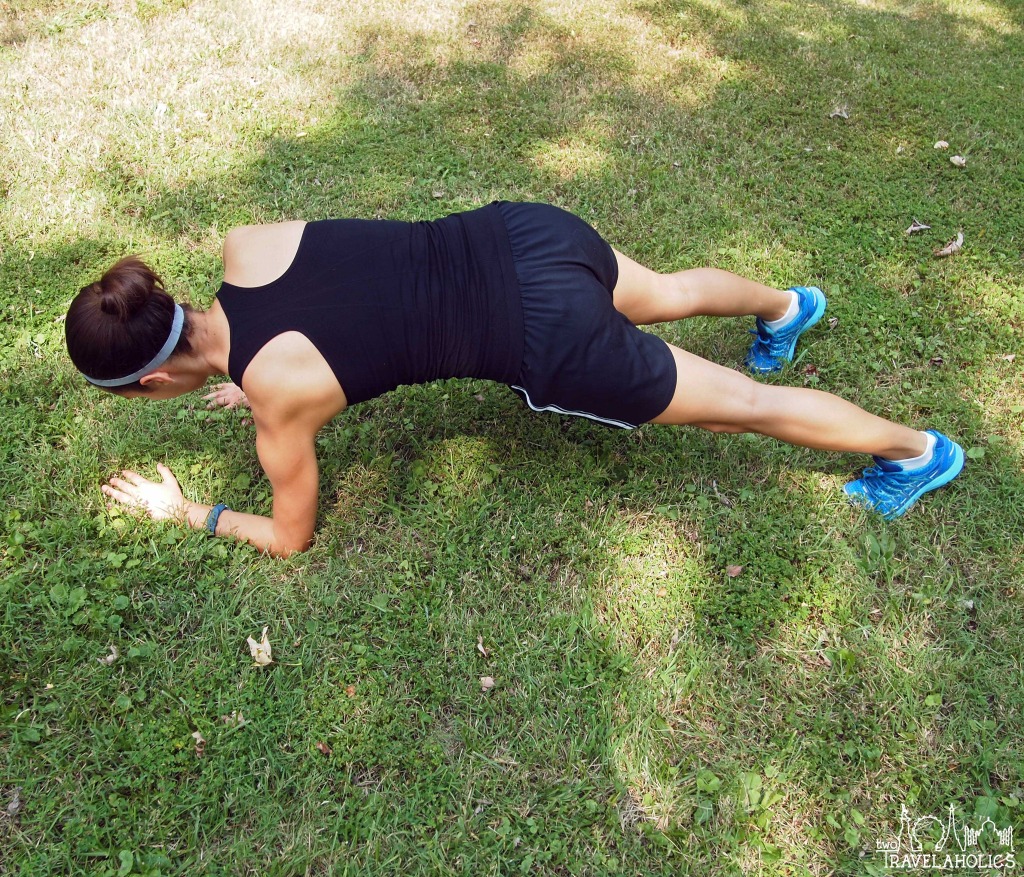
Demonstrating the arm get-up exercise (returning to pushup position with the right hand first, followed by the left).
Arm get-ups for everyone: Find a soft spot, ideally a folded towel on the floor. The starting position is pushup position (keep your core braced throughout the exercise). You’re going to do the same sequence as the intermediate leg get-ups, “down, down, up, up.” Bring your right arm down so your forearm and elbow rest on the ground, then follow with your left arm in the same way. Come back up onto your hands, leading with the right hand, then following with the left. “Down, down, up, up.” After 10 reps with your right side leading the way, take a break and switch to the left side (that will complete one set). If this becomes too easy, move quicker and do not pause in-between leading arms. Max out at two sets.
Legs
Beginner: For the leg portion, find a chair, bench or step that is at least one foot off the ground (the higher the harder your muscles will work). Let’s start by leading with the right leg. You are going to step up with the right foot, then bring your left foot to the top of the platform. Now that you’re standing on the platform with both feet, bring your right leg down first, followed by your left. The sequence is “up, up, down, down.” Repeat for 30 seconds, then switch leading legs. Speed up for more of a challenge. Your goal is to reach a maximum of 60 seconds per leading leg (one set). When you feel confident doing two sets, move on to the intermediate exercise.
Intermediate (do not attempt this if you have knee problems): Do the beginner’s set, as well as this: Find a soft spot on the floor (carpet or a folded towel) and start by standing right behind it. The sequence is similar to the beginner’s exercise, but this time it is “down, down, up, up.” First, go down onto your right knee, then down onto your left. Each leg should be at a 90° angle before you start to stand up again. Lead with the same leg by pushing up with your right foot followed by your left. Then “down, down, up, up,” still leading with your right leg. Do this for 30-60 seconds, maxing out at 60 seconds, then switch leading legs (this will complete one set). Aim for two sets.
Want to make it more challenging? Speed up or do it sideways. To do it sideways, step your inside foot to the platform while driving your outside knee up toward your chest. Return to starting position by stepping your outside leg down first. Then repeat. Do the same amount of time and sets as the intermediate exercise.
3. Squat + Squat Jumps
This exercise requires three sets. You will do 10 beautiful squats, nice and low with your hands in front of your chest. After basic squats, you will either do 10 squat pulses (beginner) or 10 squat jumps (intermediate). Now you will repeat this sequence two more times for a total of 30 squats and 30 squat pulses or jumps.
Beginner: First, complete 10 squats. Then, as with exercise one, you will do a set of pulse instead of a jump. In squat position, bob your hips up and down a few inches. Try to balance on your heels and keep your hips back. (Putting your weight on your toes will put stress on your knee and not target the right muscles.) Do 10 pulses, then stand up, shake your legs out and compete two more sets.
Intermediate: First, complete 10 squats (you can hold weighted objects for more of a challenge). For the squat jump, clasp your hands behind your head with your elbows pointed out (called a prisoner squat position). Sit into a low squat, then jump vertically as high as possible. Immediately sink back into a low squat position before repeating 10 times total. Try doing one set quickly and another slowly to see which is more of a challenge.
4. Sideways Crawl with Pushups
Beginner: In a pushup position, brace your core and crawl to the right five paces. Do this by bringing your left arm and leg toward the right side, then move away with your right arm and leg. Do this five times in the same direction before heading back the other way (this time start by moving your right arm and leg toward your left side). If this feels ok, add a pushup in the beginning, before you reverse directions and at the end. Strive for two sets.
Intermediate: Similar to the beginner exercise, you are going to crawl in one direction for five reps before reversing. The difference is that you are going to add a pushup in-between each rep. For example, start with a pushup, then bring your left arm and leg toward the right side. Bring your right arm and leg out, then do another pushup. Don’t forget to keep your core tight! Repeat for a total of five reps before reversing to the other direction. Complete two-three sets.
5. Long Jump Burpees
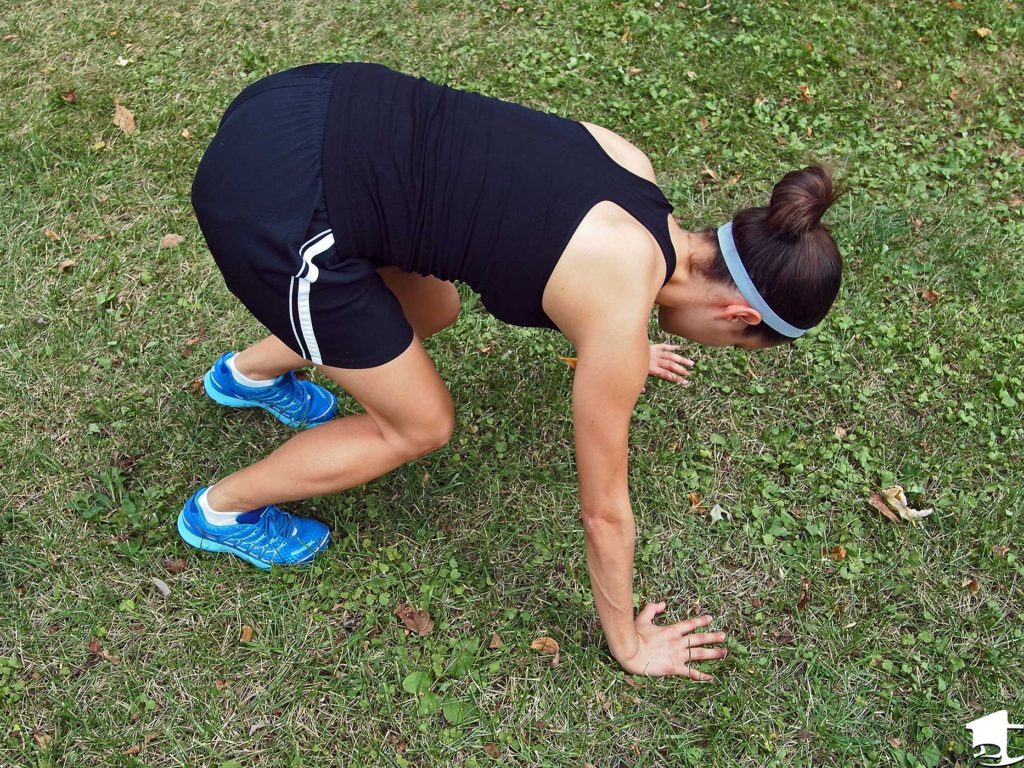
Demonstrating the midway part of a burpee, after you complete a pushup and jump your feet in toward your hands.
What’s a burpee? Start in standing position with your arms by your side. Next, squat down and set your hands flat on the ground on either side of you (like a frog). Keep your hands on the ground while jumping your legs back into a pushup position. Complete one full pushup. Then, jump both of your feet inward toward your hands (returning to your “frog” position). Now, jump straight up as high as you can, reaching your hands toward the sky. After the jump, you will land into the starting position. That’s one burpee.
Beginner: Perform 10 burpees, as described above, but leave out the pushup component. Once you become comfortable and more confident, add in a pushup every other burpee and eventually a pushup during each burpee. Do one set of 10. When you are able to complete 10 perfect burpees, try for a second set of 10.
Intermediate: Find a long hallway or area that is about 30 feet long. Execute a basic burpee, and then jump forward as far as you can. That’s one long jump burpee. When you land, complete another burpee, then do another standing long jump. Once you hit a wall or the end of the path, turn around and repeat. The trick is, the farther forward you can jump, the fewer burpees you must complete. Ideally, you will complete 10-20 long jump burpees. Don’t forget to take breaks as needed and drink plenty of water. This is a tough and exhausting exercise!
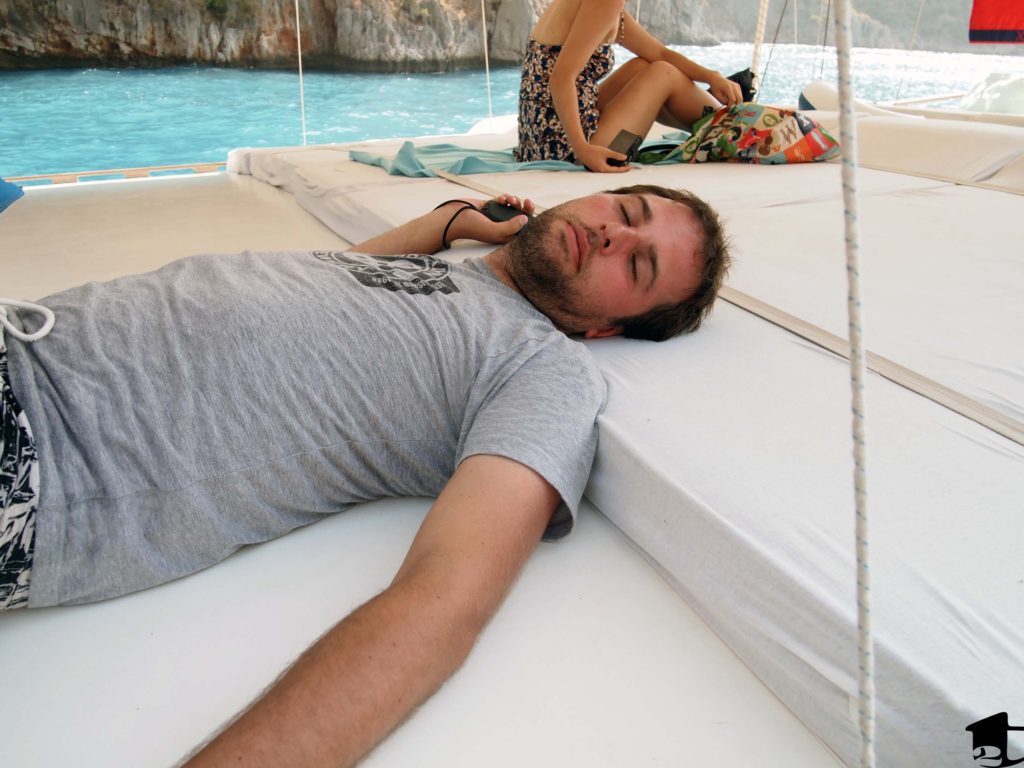
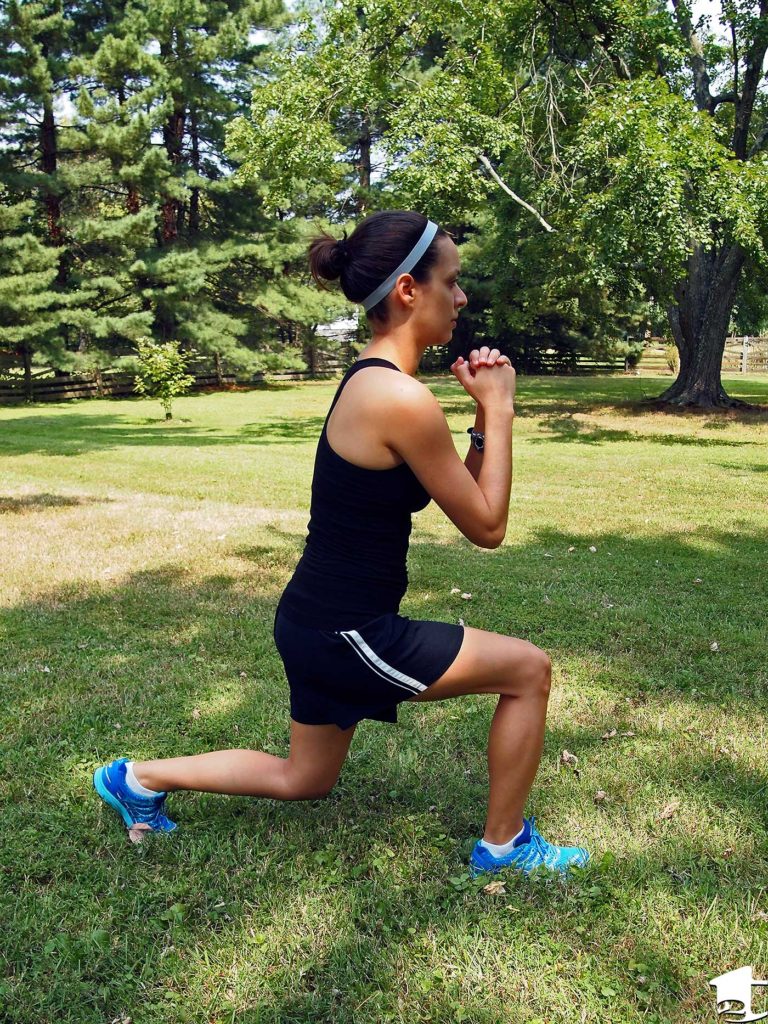
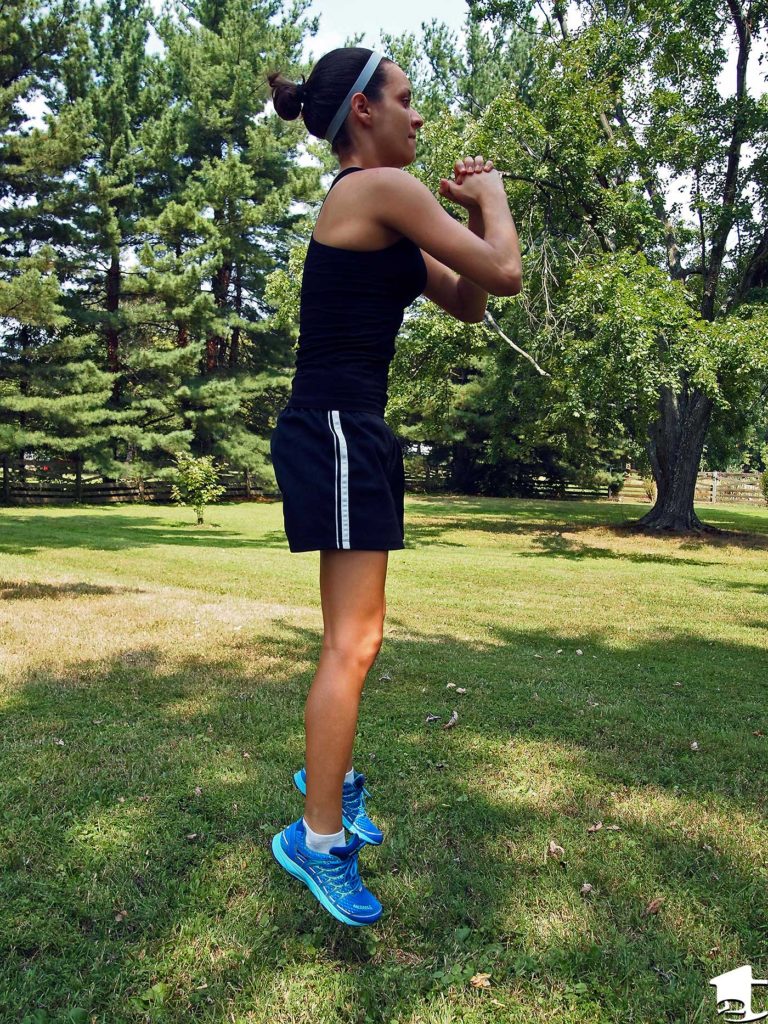












This is brilliant! I’m about to go on a long trip and am wondering about how to keep up with exercising whilst on the move. I also love running, though I’ve never really done a lot when on holiday. I’m thinking of using running as a way to explore a new city whenever I move around (though am worried about how much laundry I’ll have to do!) 🙂
I’m glad you find it helpful! Running is a great way to explore a new city. Just be a smart runner like you would be at home – don’t run at night, run in public places with plenty of space, skip the headphones and be on alert. Constant sink laundry was certainly the worst part. It’s worth it though!
I’ve been following your blog since before we went away, as your planning posts are fab. But I’ve popped back in at the 6 month mark where I’m starting to feel a bit bleurgh you know? I’m no gym bunny, but even with all the walking — it’s hard to feel healthy when you’re eating out so often and rarely getting your heart rate up to cardio levels!
These exercises are great, and I’m incorporating few into my current routine of core work….I’ll let you know how I get on!
Lucy
That’s great to hear! We can relate to feeling like you’re in a funk. It’s definitely a balancing act when you’re on the road. We started our own road routine so we could be sure we were exercising enough. You just have to find something that works for you both and support each other through it. Definitely let me know how it goes!